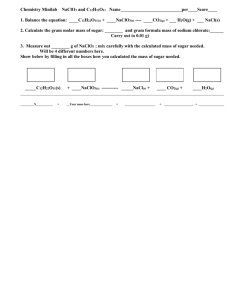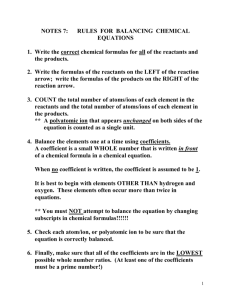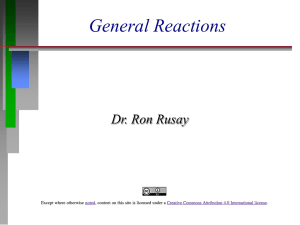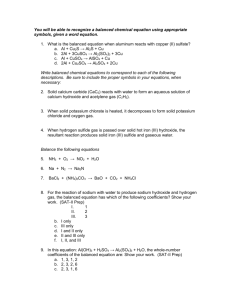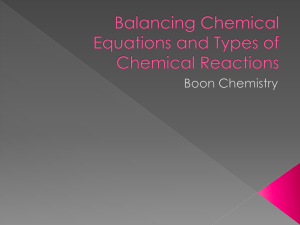PPT ON BALANCING CHEMICAL EQUATION
advertisement
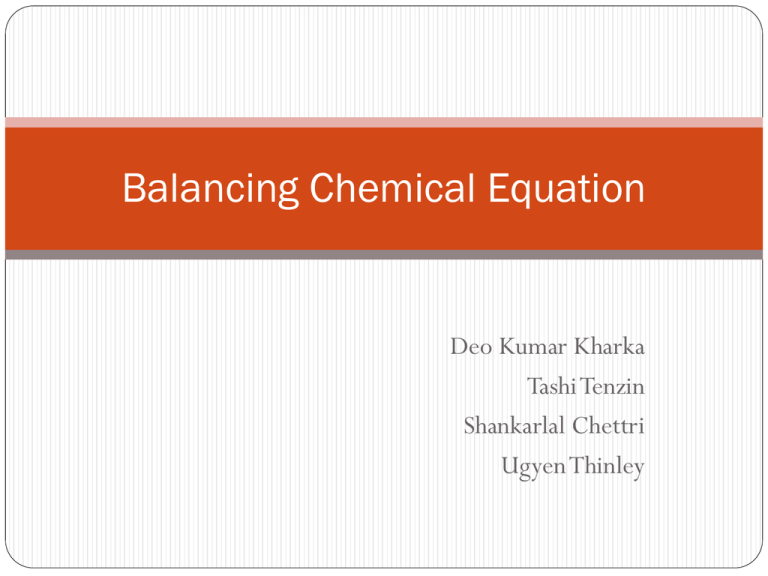
Balancing Chemical Equation Deo Kumar Kharka Tashi Tenzin Shankarlal Chettri Ugyen Thinley What is chemical equation? Chemical reaction equations are mathematical and symbolic models of real world compound and events. When a chemical reaction occurs, it can be described by an equation. This shows the chemicals that react (called the reactants) on the lefthand side, The chemicals that they produce (called the products) on the righthand side. The chemicals can be represented by their names or by their chemical symbols. Unlike mathematical equations, the two sides are separated by an arrow, that indicates that the reactants form the products and not the other way round. There could be two kinds of equation: 1. skeleton equation - is an equation which just represents a chemical change but it is not – balanced. Eg. KNO3 KNO2 + O2 2. balanced equation –is the equation in which the total number of atoms in the reactant is same as the number of the atom in the product formed. Eg. 2KNO3 2KNO2 + O2 How to balance the chemical equation 1. Count the number of times (frequency) an element is occurring on the both the sides. 2. an element with less frequency is balanced first. 3. when two or more elements have same frequency then metallic element is preferred. Methods 1. Inspection/hit and trail method 2. Algebraic method 3. Partial equation method Hit and Trial method Eg. NH4NO3 Right hand side N=2 O=3 N2O + H2O left hand side N=2 (balanced) O=2 (not balanced) H=4 H=2 (not balanced) O and H can be balance by adding coefficient 2 to the H2O NH4NO3 N2O +2 H2O Algebraic method EG. C4H10 + O2 CO2 + H20 put unknown coefficients in front of each molecular species in the equation: xC4H10 + yO2 zCO2 + wH20 write down the balance conditions for each element in terms of the unknowns (x,y,z,w). Carbon balance: 4x= z Hydrogen balance condition is: 10x=2w oxygen balance condition gives: 2y= 2z + w We should recognize that chemical equations specify relative amounts of reactants and products. Thus, one of the coefficients is arbitrary. we may take one of the coefficients to be 1. (according to convenience) o Assume x= 1, 4x= z therefore, z= 4 10x=2w therefore, w= 5 from oxygen balance condition, y= 2z + w 2y = 2 x 4 + 5 y= 13/2 Thus, the balanced equation could be written as : C4H10 + 13/ 2 O2 4CO2 + 5H20 Multiply through the equation by 2 on both sides (it can be treated as an algebraic equation in this way) C4H10 + 13/2 O2 4CO2 + 5H20 2C4H10 + 13 O2 8CO2 + 10H20 Partial Equation Method When equations contain many reactants and products they cannot be balanced by the hit and trial method. They are then balanced by the partial equation method. In this method the overall reaction is assumed to take place through two or more simpler reactions, which can be represented by partial equations. Steps: Split the chemical equation into two or more partial equations. Na OH + Cl2 NaCl +NaClO3 + H2O Partial eq.1 Na OH + Cl2 NaCl +NaClO + H2O Partial eq.2 NaClO NaClO3 +NaCl I. ii. Each partial equation is separately balanced by the hit and trial method. Balanced Partial eq.1 2NaOH + Cl2 Balanced Partial eq.2 3 NaClO NaCl + NaClO + H2O NaClO3 + 2NaCl These balanced partial equations are multiplied with suitable coefficients in order to exactly cancel out those common substances which do not appear in the overall chemical equations. 2NaOH + Cl2 NaCl + NaClO + H2O….. X 3 The balanced partial equations so obtained, are added to arrive at the balanced chemical equation. 6NaOH +3 Cl2 3NaCl + 3 NaClO + 3H2O 3 NaClO 6NaOH +3Cl2 NaClO3 + 2NaCl 5NaCl + NaClO3 + H2O

